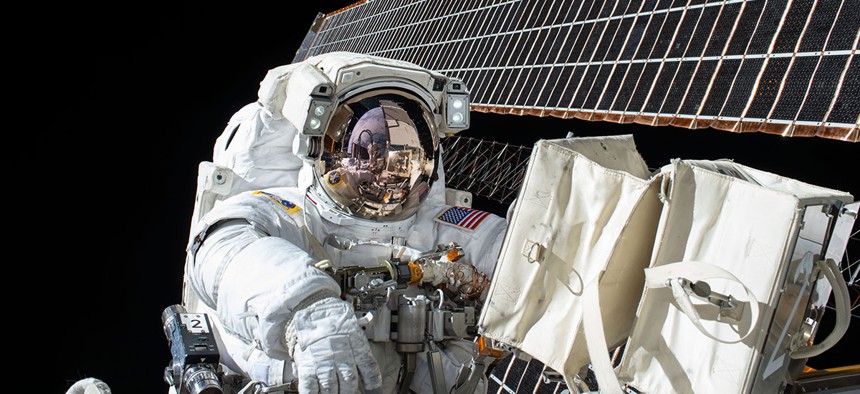
NASA astronaut Scott Kelly conducts a spacewalk in November. NASA
NASA's 2016 Budget Is the Biggest in At Least a Decade
The space agency is going to spend some of the money on planetary-science missions.
If Congress passes the omnibus spending bill that it’s now considering, the National Aeronautics and Space Administration will enjoy a larger budget in 2016 than it has had in at least half a decade.
NASA will be able to spend $19.3 billion next year, according to the budget, an increase of more than $1.3 billion over 2015 funding levels. That’s $700 million more than the funding requested by the White House.
“Everyone who supports space should be very pleased with this, if it passes as is,” said Casey Dreier, the director of advocacy at the Planetary Society. “This is a great budget.”
NASA did not return a request for comment.
2016 will be a busy year for the U.S. space agency. If all goes well, the geological mission InSight will land on the surface of Mars, the robotic orbiter Juno will reach Jupiter, and OSIRIS-REx will launch from Earth. OSIRIS aims to eventually touch down on the surface of the asteroid Bennu, spend almost two years there, then send a capsule home to this planet with asteroid samples.
All three of these missions are planetary-science missions, housed in the only NASA division which visits worlds beyond our own. The New Horizons probe that visited Pluto this year was also a planetary-science mission. Dreier noted that the 2016 budget restores historically normal levels of funding to NASA planetary science, which had seen its budget sliced by 25 percent in the early part of this decade.
Because of those cuts, no new planetary-science missions will fly from the end of 2016 to the beginning of 2020. Dreier said this was “the longest gap in planetary science in at least 20 years.”
At the end of that period, as well, the one-year Juno mission at Jupiter and the 11-year-old Cassini-Huygens mission at Saturn will draw to a close.
“For the first time since the early 1970s, the U.S. will not have a robotic presence in the giant planets of the outer solar system” at that time, said Dreier.
After 2020, NASA is expected to launch new robotic missions to Mars andEuropa, a moon of Jupiter believed to be more amenable to life than other worlds in the solar system. (A Congressional report attached to the 2016 budget encouraged NASA to make the Europa mission a rover, rather than a lander or an orbiter. Dreier said he was not sure whether NASA would obey the report.)
Beyond planetary science, the coming years are likely to be busy for NASA. In 2017, the agency hopes to complete its commercial-crew development programwith SpaceX and Boeing, which will once again launch allow crewed missions to fly to the International Space Station from American soil. It also hopes to advance its Space Launch System, the largest U.S. rocket system constructed since the Apollo era’s Saturn V. The Space Launch System will permit crewed missions to travel past the moon and robotic missions to reach gas giants and the outer solar system without using the gravity slingshot of Earth or Venus.
The commercial-crew development receives $1.2 billion, as much funding as it will ever need in one year, in the proposed 2016 budget. The Space Launch System will receive $2 billion.
One of the few divisions of NASA to receive less funding than requested by the White House is Earth science. That field studies many parts of our home world, including its atmosphere, geology, and hydrology, and it also includes NASA’s climate division. Earth science will get $1.921 billion overall, an increase of $149 million from last year’s budget.
Dreier said that despite being funded below President Obama’s request, 2016 would see the largest Earth science budget in at least five years.
“NASA is perennially underfunded,” he told me. “People say it has 20 pounds of missions in a 10-pound bag. The nation asks it to do all its stuff and then gives it half the money that it needs.”
Back in October, the Planetary Society, the world’s largest space-science advocacy group, put together the best NASA budget it could imagine. It dubbed this budget the “everybody wins” scenario. The NASA budget unveiled this week, Dreier said, contained the same amount of money as that fanciful October budget.
“I don’t often do this with a smile on my face,” he said. He had one today.







